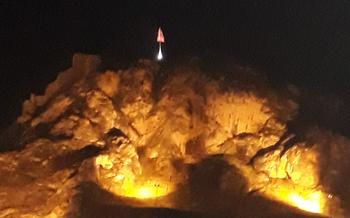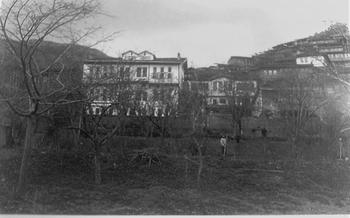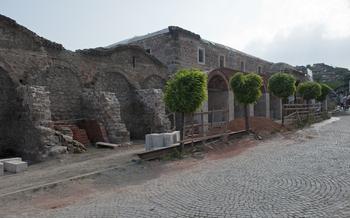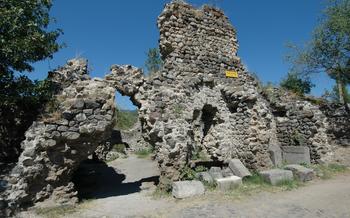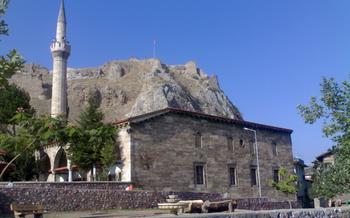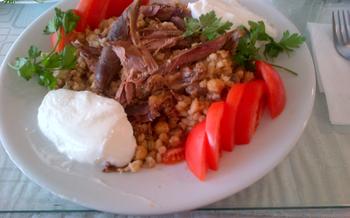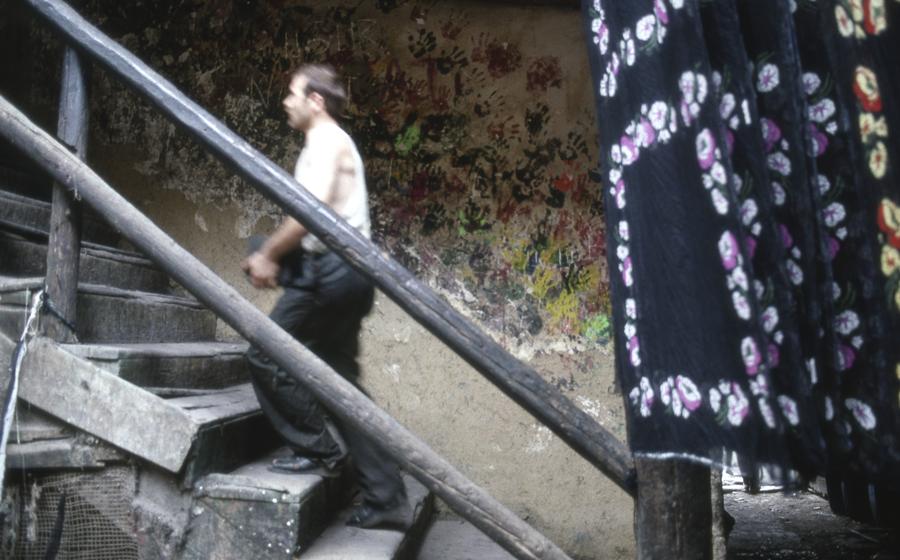
Niksar Osman Gazi Bridge
- Niksar Osman Gazi Bridge: A Contemporary Architectural Marvel
- Location and Accessibility
- Architectural Features
- Observation Decks and Panoramic Views
- Engineering Feats and Innovations
- Role in Regional Development
- Local Culture and Heritage
- Outdoor Activities and Recreation
- Historical Landmarks Nearby
- Accommodation Options for Travelers
- Local Cuisine and Dining
- Shopping and Souvenirs: A Journey Through Local Craftsmanship
- Safety and Security
- Insider Tip: Unveiling a Hidden Gem
Niksar Osman Gazi Bridge: A Contemporary Architectural Marvel
The Niksar Osman Gazi Bridge stands as a testament to modern engineering and architectural prowess. Designed by renowned architects, the bridge seamlessly blends innovative design with functional efficiency, creating a structure that is both visually stunning and remarkably sturdy. Its unique cable-stayed design, featuring two towering pylons and a sleek suspension deck, sets it apart from conventional bridges, giving it a distinctive and contemporary appearance.
Beyond its aesthetic appeal, the bridge holds historical significance as a symbol of progress and connectivity in the region. Spanning the majestic Tokat River, it connects the vibrant city of Tokat with the rural landscapes beyond, fostering economic growth and cultural exchange. The bridge's construction has played a pivotal role in improving transportation infrastructure, reducing travel time, and facilitating trade and tourism.
The engineering marvel behind the Niksar Osman Gazi Bridge is equally impressive. Constructed using state-of-the-art techniques and materials, the bridge has been meticulously designed to withstand the region's seismic activity and harsh weather conditions. Its robust structure ensures the safety of commuters and visitors while providing a smooth and comfortable driving experience.
Moreover, the bridge's contribution to the region's infrastructure is undeniable. As a vital link in the transportation network, it has significantly improved connectivity, reduced travel distances, and stimulated economic activity. The bridge serves as a gateway to the region, inviting travelers and investors to explore its rich cultural heritage, natural wonders, and untapped potential.
Location and Accessibility
The Niksar Osman Gazi Bridge is strategically located in the city of Niksar, within the Tokat province of Turkey. Its proximity to major cities like Sivas and Amasya makes it an important transportation hub connecting the region's eastern and western parts. The bridge is easily accessible by road, with well-maintained highways leading directly to its entry points. Visitors can also opt for public transportation, as the bridge is serviced by regular bus routes from nearby towns and cities.
Beyond its transportation significance, the Niksar Osman Gazi Bridge offers a picturesque setting amidst stunning natural landscapes. The bridge spans across the Yeşilırmak River, providing breathtaking views of the river's meandering course and the lush green valleys that surround it. The bridge itself becomes a focal point of the landscape, adding a modern architectural element to the region's natural beauty.
For those planning a visit, a range of accommodation options is available near the bridge. From budget-friendly guesthouses to comfortable hotels, visitors can choose a place to stay that suits their needs and preferences. Whether you're seeking a short stopover or a longer stay to explore the region, the Niksar Osman Gazi Bridge serves as a convenient gateway to the wonders of Tokat, Turkey.
Architectural Features
The Niksar Osman Gazi Bridge is a testament to modern architectural prowess, blending functionality with aesthetics. Its design draws inspiration from Turkish architectural traditions, incorporating elements that reflect the region's cultural heritage. The bridge's pylons, resembling towering minarets, are adorned with intricate tilework and calligraphy, paying homage to Islamic art and craftsmanship.
The bridge's structural composition showcases the latest engineering techniques. Constructed using high-tensile steel cables and reinforced concrete, it can withstand seismic activity and high winds, ensuring the safety of travelers. The bridge's deck is designed to minimize traffic congestion, featuring multiple lanes and wide shoulders for smooth traffic flow.
The Niksar Osman Gazi Bridge is a visual masterpiece, particularly at night when illuminated by energy-efficient LED lights. Its graceful silhouette against the backdrop of the starry sky creates a breathtaking spectacle, transforming the bridge into a beacon of light and progress.
Comparisons to other notable bridges worldwide reveal the Niksar Osman Gazi Bridge's uniqueness. While sharing similarities in terms of structural design and functionality with bridges like the Golden Gate Bridge in San Francisco or the Millau Viaduct in France, it stands out with its distinct architectural features and cultural influences, making it a remarkable landmark in its own right.
Observation Decks and Panoramic Views
The Niksar Osman Gazi Bridge offers elevated observation decks that provide breathtaking vistas of the surrounding landscape. Ascending to these viewing platforms grants visitors an unparalleled perspective of Tokat city, where they can admire the sprawling urban tapestry adorned with historical landmarks, modern skyscrapers, and verdant parks. The panoramic views extend far beyond the city limits, encompassing the lush green valleys, meandering river, and distant mountain ranges.
These observation decks serve as ideal vantage points for capturing stunning photographs that encapsulate the bridge's architectural grandeur against the backdrop of the picturesque surroundings. Whether it's the golden hues of sunrise casting a warm glow on the landscape or the twinkling city lights illuminating the night sky, the bridge offers endless opportunities for creating lasting memories through photography.
Accessibility is a key consideration for the bridge's designers, ensuring that visitors from all walks of life can enjoy the panoramic vistas. Elevators and ramps provide convenient access to the observation decks, catering to individuals with disabilities and ensuring an inclusive experience for all. Admission fees are nominal, and operating hours are flexible, allowing visitors to plan their visit at their convenience.
Engineering Feats and Innovations
The Niksar Osman Gazi Bridge stands as a testament to modern engineering ingenuity and innovation. Its cable-stayed design, featuring a single pylon supporting the deck with a network of steel cables, is a marvel of structural engineering. The bridge's pylons, reaching over 150 meters in height, are not only visually striking but also serve as anchors for the cables, ensuring stability and load distribution. The bridge's construction faced significant challenges due to the complex geological conditions and seismic activity in the region. Earthquake-resistant features, such as base isolators and dampers, were incorporated into the design to mitigate seismic risks and ensure the bridge's resilience against earthquakes. Moreover, the bridge showcases eco-friendly elements, including energy-efficient lighting systems and rainwater collection systems, demonstrating a commitment to sustainability. The Niksar Osman Gazi Bridge has received numerous accolades for its engineering excellence and innovative design, including the prestigious "Outstanding Structure Award" from the International Association for Bridge and Structural Engineering (IABSE).
Role in Regional Development
The Niksar Osman Gazi Bridge is not merely an architectural marvel; it also plays a pivotal role in the socio-economic development of the Tokat region. By bridging the gap between isolated communities, it has significantly improved transportation efficiency, fostering trade and economic growth. The bridge has opened up new avenues for commerce, enabling local businesses to connect with markets beyond their immediate vicinity.
The bridge's strategic location has catalyzed the establishment of new businesses and industries, creating employment opportunities and boosting the local economy. It has also played a crucial role in attracting investment to the region, leading to the development of new residential and commercial areas. The bridge's presence has acted as a catalyst for urban development, revitalizing existing communities and transforming the region into a more vibrant and prosperous hub.
Looking ahead, the Niksar Osman Gazi Bridge holds immense potential for further driving economic growth and shaping the future development of the region. Its strategic connectivity could attract foreign investment, leading to the establishment of new industries and the creation of skilled jobs. The bridge is expected to play a central role in promoting sustainable tourism, attracting visitors from around the world who seek to experience its architectural grandeur and the region's rich cultural heritage.
Local Culture and Heritage
The region surrounding the Niksar Osman Gazi Bridge is a treasure trove of cultural and historical significance, offering visitors a glimpse into the area's rich past and vibrant traditions. Delve into the history of ancient civilizations that once thrived here, leaving behind fascinating ruins and archaeological sites that tell tales of forgotten empires. Explore local museums and cultural institutions to uncover the region's artistic heritage, showcasing traditional crafts, paintings, and sculptures that reflect the unique identity of the people.
Indulge in the region's culinary delights, savoring traditional dishes that have been passed down through generations. Visit local markets and bazaars to shop for fresh produce, spices, and ingredients, immersing yourself in the vibrant atmosphere and bargaining with friendly vendors. Don't miss the opportunity to participate in cooking workshops or classes, where you can learn to prepare authentic local dishes and take home a taste of the region's culinary traditions.
Outdoor Activities and Recreation
The Niksar Osman Gazi Bridge is not just an architectural marvel; it also serves as a gateway to outdoor adventures and recreational activities. Nature enthusiasts can embark on scenic nature trails and hiking paths that meander through the picturesque landscapes surrounding the bridge. These trails offer opportunities for exploration, relaxation, and a chance to connect with the area's natural beauty.
For those seeking a more active experience, the nearby river or lake provides ample opportunities for water sports and boating. Visitors can kayak through the tranquil waters, cast their lines for a spot of fishing, or embark on a leisurely boat tour to admire the stunning scenery from a different perspective.
For a more laid-back experience, visitors can opt for a picnic along the riverbank, enjoying a leisurely meal while soaking in the tranquil environment and breathtaking views. The area also offers designated cycling trails or scenic bike routes that pass near the bridge, inviting visitors to explore the surroundings on two wheels and pedal their way through nature's wonders.
Historical Landmarks Nearby
The Niksar Osman Gazi Bridge is surrounded by a wealth of historical landmarks that offer a glimpse into the region's rich past. A short drive from the bridge, visitors can explore the ancient ruins of Tokat Castle, which dates back to the Byzantine era and offers breathtaking views of the city and the surrounding countryside. Another must-visit site is the Tokat Museum, which houses a vast collection of artifacts and exhibits showcasing the region's history and culture. For those interested in religious architecture, the Ulu Mosque, built in the 12th century, is a stunning example of Seljuk architecture and a testament to the region's diverse religious heritage. Additionally, the Sulusaray Han, a 13th-century caravanserai, provides a glimpse into the region's past as a major trading hub. With its proximity to these historical treasures, the Niksar Osman Gazi Bridge offers visitors a chance to delve into the rich tapestry of Tokat's past and gain a deeper appreciation for its cultural significance.
Accommodation Options for Travelers
When planning a visit to the Niksar Osman Gazi Bridge, travelers have a range of accommodation options to choose from, catering to different budgets and preferences. For those seeking a comfortable and convenient stay, there are several hotels and guesthouses located near the bridge, offering modern amenities and easy access to local attractions.
For a more unique experience, travelers can opt for traditional guesthouses or farm stays, which provide an immersive cultural experience and a chance to connect with the local community. These accommodations often offer traditional Turkish hospitality, delicious home-cooked meals, and insights into the region's rich cultural heritage.
Adventurous travelers who prefer to be closer to nature can choose from designated camping sites or outdoor accommodation options. These campsites offer a serene and tranquil environment, allowing visitors to camp under the stars and wake up to breathtaking views of the bridge and the surrounding landscapes.
For those seeking a truly authentic experience, homestays or cultural exchange programs offer a chance to stay with local families and immerse themselves in the daily life of the region. This is a great way to learn about local customs, traditions, and cuisine, and to make lasting connections with the warm and welcoming people of Tokat.
Local Cuisine and Dining
The Niksar Osman Gazi Bridge region is a culinary paradise, offering a tantalizing array of traditional dishes, street food, and culinary specialties that are sure to delight your taste buds. Indulge in the succulent flavors of freshly grilled kebabs, tantalize your palate with the aromatic spices of local stews, and savor the sweetness of traditional desserts like baklava and güllaç.
For an authentic dining experience, venture into the heart of Tokat city and explore the bustling local markets and bazaars. Here, you'll find an array of fresh produce, spices, and traditional ingredients that will inspire your culinary adventures. Join a cooking workshop or class to learn the secrets of local cuisine from experienced chefs, and recreate these delectable dishes in your own kitchen.
Whether you prefer the lively atmosphere of a local restaurant or the tranquility of a riverside cafe, you'll find plenty of options to satisfy your cravings. Don't miss the opportunity to sample the region's famous trout, freshly caught from the nearby river and grilled to perfection. And as you savor the delicious flavors of Tokat's cuisine, be sure to engage with the friendly locals, who are always eager to share their culinary traditions and stories.
Shopping and Souvenirs: A Journey Through Local Craftsmanship
The vibrant handicraft scene surrounding the Niksar Osman Gazi Bridge offers a treasure trove of unique souvenirs and locally produced goods. Visitors can delve into the intricate world of handmade pottery, where skilled artisans create exquisite ceramics, each piece a testament to their mastery. The vibrant textiles, adorned with traditional motifs and patterns, reflect the region's rich cultural heritage. Handcrafted jewelry, meticulously crafted with local materials, adds a touch of elegance and authenticity to any collection.
Beyond the traditional crafts, visitors can discover locally produced goods such as textiles, carpets, and jewelry, each showcasing the region's unique craftsmanship. These products, infused with the spirit of the region, serve as tangible mementos of a journey to this captivating destination.
To fully immerse in the local shopping experience, visitors can explore the bustling bazaars and markets, where vendors display their wares in a kaleidoscope of colors and textures. Bargaining, an integral part of the local culture, is not just a transaction but a social interaction, allowing visitors to connect with the friendly locals and secure the best deals.
Whether seeking a handcrafted souvenir to cherish or a locally produced item to adorn their homes, visitors are sure to find treasures that capture the essence of the Niksar Osman Gazi Bridge and the region it connects.
Safety and Security
Navigating Tokat's Enchanting Locale with Peace of Mind
Tokat welcomes travelers with open arms, ensuring their safety and security throughout their visit. The local community is known for its warm hospitality and willingness to assist visitors in any way they can. General safety guidelines apply, such as being aware of your surroundings, keeping valuables secure, and respecting local customs.
For solo travelers, exploring Tokat can be an enriching experience. It's advisable to choose well-lit areas, opt for guided tours or group activities, and stay connected with friends or family by sharing your itinerary.
In case of emergencies, there are several resources available. Hospitals, police stations, and tourist assistance centers are well-equipped to handle any situation that may arise. The staff is generally multilingual and eager to assist visitors in any way possible.
Remember, respecting local customs and traditions is essential for a harmonious travel experience. Dressing modestly, avoiding public displays of affection, and refraining from photographing sensitive sites are signs of respect for the local culture.
By following these simple guidelines and embracing the welcoming spirit of Tokat, visitors can fully immerse themselves in the region's charm and create lasting memories.
Insider Tip: Unveiling a Hidden Gem
Beyond the grandeur of the Niksar Osman Gazi Bridge, a hidden gem awaits those who dare to venture off the beaten path. Nestled amidst the lush greenery that surrounds the bridge, a secluded waterfall cascades down a rocky cliff, creating a breathtaking natural spectacle. The sound of the rushing water and the mist that rises from the falls create a serene and tranquil atmosphere, inviting visitors to immerse themselves in the beauty of nature. Whether you choose to admire the falls from a distance or embark on a short hike to get a closer look, this hidden oasis offers a unique and unforgettable experience for nature enthusiasts and adventurous travelers alike.
